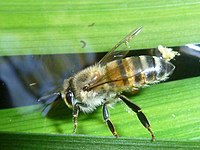
The impact of pollen consumption on honey bee (Apis mellifera) digestive physiology and carbohydrate metabolism.
Sign Up to like & getrecommendations! Published in 2017 at "Archives of insect biochemistry and physiology"
DOI: 10.1002/arch.21406
Abstract: Carbohydrate-active enzymes play an important role in the honey bee (Apis mellifera) due to its dietary specialization on plant-based nutrition. Secretory glycoside hydrolases (GHs) produced in worker head glands aid in the processing of floral… read more here.
Keywords: pollen consumption; physiology; honey; honey bee ... See more keywords

Admixture in Africanized honey bees (Apis mellifera) from Panamá to San Diego, California (U.S.A.)
Sign Up to like & getrecommendations! Published in 2022 at "Ecology and Evolution"
DOI: 10.1002/ece3.8580
Abstract: Abstract The Africanized honey bee (AHB) is a New World amalgamation of several subspecies of the western honey bee (Apis mellifera), a diverse taxon historically grouped into four major biogeographic lineages: A (African), M (Western… read more here.
Keywords: honey; ancestry; admixture; honey bee ... See more keywords

Honey Bee (Apis mellifera) Exposure to Pesticide Residues in Nectar and Pollen in Urban and Suburban Environments from Four Regions of the United States
Sign Up to like & getrecommendations! Published in 2022 at "Environmental Toxicology and Chemistry"
DOI: 10.1002/etc.5298
Abstract: The risk of honey bee (Apis mellifera L.) exposure to pesticide residues while foraging for nectar and pollen is commonly explored in the context of agroecosystems. However, pesticides are also used in urban and suburban… read more here.
Keywords: nectar pollen; honey bee; pesticide residues; urban suburban ... See more keywords

BeeGUTS—A Toxicokinetic–Toxicodynamic Model for the Interpretation and Integration of Acute and Chronic Honey Bee Tests
Sign Up to like & getrecommendations! Published in 2022 at "Environmental Toxicology and Chemistry"
DOI: 10.1002/etc.5423
Abstract: Understanding the survival of honey bees after pesticide exposure is key for environmental risk assessment. Currently, effects on adult honey bees are assessed by Organisation for Economic Co‐operation and Development standardized guidelines, such as the… read more here.
Keywords: toxicology; honey; honey bee; model ... See more keywords

Using the Honey Bee (Apis mellifera L.) Cell Line AmE‐711 to Evaluate Insecticide Toxicity
Sign Up to like & getrecommendations! Published in 2022 at "Environmental Toxicology and Chemistry"
DOI: 10.1002/etc.5500
Abstract: One of the main contributors to poor productivity and elevated mortality of honey bee colonies globally is insecticide exposure. Whole‐organism and colony‐level studies have demonstrated the effects of insecticides on many aspects of honey bee… read more here.
Keywords: toxicology; cell; honey bee; ame 711 ... See more keywords

Efficiency of an air curtain as an anti-insect barrier: the honey bee as a model insect.
Sign Up to like & getrecommendations! Published in 2018 at "Pest management science"
DOI: 10.1002/ps.5090
Abstract: BACKGROUND Vector-borne diseases are of high concern for human, animal and plant health. In humans, such diseases are often transmitted by flying insects. Flying insects stop their flight when their kinetic energy cannot compensate for… read more here.
Keywords: insects; air curtain; air; efficiency ... See more keywords

Assessment of acute and chronic toxicity of cyantraniliprole and sulfoxaflor on honey bee (Apis mellifera) larvae.
Sign Up to like & getrecommendations! Published in 2022 at "Pest management science"
DOI: 10.1002/ps.7162
Abstract: BACKGROUND Recently, cyantraniliprole (CYA) and sulfoxaflor (SUL) have been considered as alternatives to neonicotinoid insecticides. In this study, we evaluated the acute and chronic toxicities of CYA and SUL on honey bee (Apis mellifera L.)… read more here.
Keywords: honey bee; sul; chronic toxicity; larva ... See more keywords

Performance evaluation of local honey bee race (Apis melifera secutellata) in the Metekel Zone of North Western Ethiopia
Sign Up to like & getrecommendations! Published in 2022 at "Veterinary Medicine and Science"
DOI: 10.1002/vms3.885
Abstract: Abstract Background Honeybee colonies differ in performance due to variations in their traits in terms of production, productivity and behaviour. The objective of this study was to identify and evaluate the performance of honey bee… read more here.
Keywords: honey; race; honey bee; area ... See more keywords

A spatial model of honey bee colony collapse due to pesticide contamination of foraging bees
Sign Up to like & getrecommendations! Published in 2020 at "Journal of Mathematical Biology"
DOI: 10.1007/s00285-020-01498-7
Abstract: We develop a model of honey bee colony collapse based on contamination of forager bees in pesticide contaminated spatial environments. The model consists of differential and difference equations for the spatial distributions of the uncontaminated… read more here.
Keywords: forager; collapse; colony collapse; model ... See more keywords

Predation of the invasive Asian hornet affects foraging activity and survival probability of honey bees in Western Europe
Sign Up to like & getrecommendations! Published in 2018 at "Journal of Pest Science"
DOI: 10.1007/s10340-018-1063-0
Abstract: Introduced in France more than a decade ago from China, the invasive Asian hornet Vespa velutina preys on honey bee Apis mellifera foragers at hive entrances and is a major concern for Western European beekeepers… read more here.
Keywords: colony; honey; hornet; asian hornet ... See more keywords

Thinking beyond Western commercial honeybee hives: towards improved conservation of honey bee diversity
Sign Up to like & getrecommendations! Published in 2017 at "Biodiversity and Conservation"
DOI: 10.1007/s10531-017-1404-y
Abstract: A decline of wild pollinators, along with a decline of bee diversity, has been a cause of concern among academics and governmental organizations. According to IPBES, a lack of wild pollinator data contributes to difficulties… read more here.
Keywords: honey; towards improved; bee; honey bee ... See more keywords